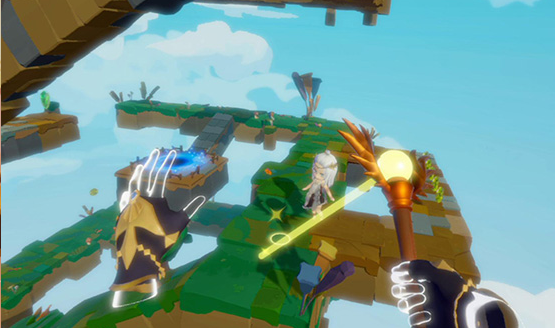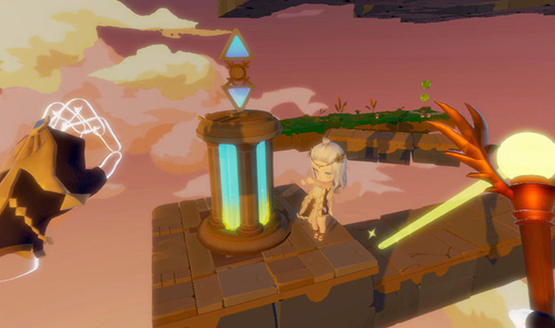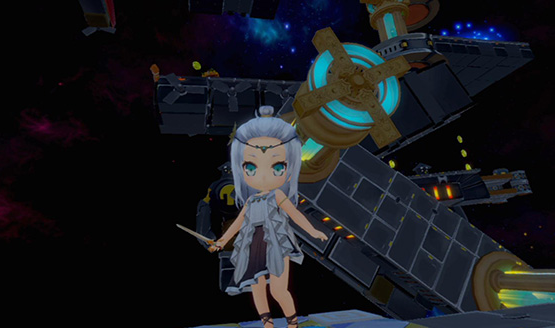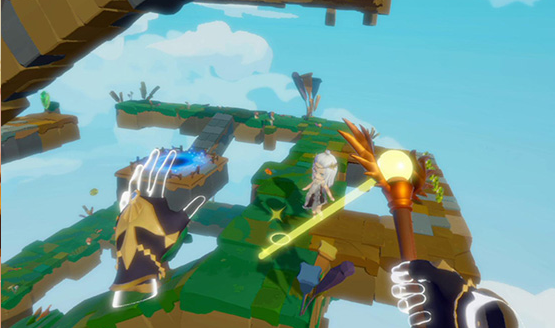I’ve played my fair share of virtual reality titles and then some, and I’m also fascinated with the innovative new ways that developers are finding to utilize the media and create new interactive experiences. Light Tracer is one such game, combining perspective, puzzles, and a unique control scheme together to craft a unique adventure guiding a princess to the top of a massive tower. Sometimes it’s the simplest of concepts that are filled with complexity.
Requiring two Move controllers, Light Tracer has players guiding the princess using a beam of light coming from a staff in one hand, while rotating and otherwise moving the environment with the other. The concept seems trivial, but creates a wonderful series of conundrums as I navigated to the top of the tower. Puzzles relied on shifting my own perspective being able to see where I wanted the princess to go on this twisting tower that rises ever higher into the heavens and beyond.
Being so used to having direct control over characters, I was forced to adjust my thinking for Light Tracer. I’m reminded of watching my mother-in-law try to play LittleBigPlanet, amused as I watched someone who had never played a platformer attempt to reconcile moving at the same time as jumping. Suddenly that was me, trying to figure out forward movement and jumping. It didn’t take long to get the hang of it, but it was a novel way to take a longtime gamer and put them back into a place of learning.
The princess will follow the beam of light anytime the trigger is pulled, meaning I had to be careful to stay on the narrow path and not waver where I was aiming. Things go from simple linear movement, to jumping over gaps, to more complex series of platforms that become much harder to navigate, let alone grab all of the crystals scattered around each level. Learning to deftly swap between adjusting my perspective and pulling the trigger so the princess would move was key to traversing the ever climbing tower, avoiding dangers, and hoping that the aim of the light was unwavering.
Tower of Challenges
New elements are introduced to each chapter that further complicate the journey. Icy platforms will make the princess slide forward. Objects in the environment will need to be moved around. One stage later on even brings a gravity change mechanic that once again requires players to shift their thinking. Now are you not only indirectly controlling the princess, she will sometimes be upside down. These elements all mix and complicate into interesting mechanics and puzzles, such as having the princess leap on a series of jelly-like bouncy platforms while a sand monster throws rocks at her. Attempting to keep track of the light beam, the rocks, and when to press the trigger, all while avoiding the rocks is a much more complex task than the cute aesthetic of the game would hint at.
One challenge required moving a series of angled walls to so that the princess could slide along the ice and reach the platform on the other side after bouncing off of them in the correct order. Another sees players moving various mechanisms within the world while also trying to aim the light with the other. It’s a lot of “pat your head and rub your stomach” level complexity as my brain tried to sync up two distinctly separate things in order to help the princess on her journey, especially the further up the tower I climbed.
I was enamored by the looks and sounds of Light Tracer, though after a time I found that the soundtrack tended to wear on and on, playing the same few tracks again and again. The songs ranged from soothing acoustic guitar, to a sort of spaghetti western, grindhouse style. A later song reminded me of those from 1960s sitcoms like Leave it to Beaver, a jaunty and catchy little tune that highlighted the silliness of guiding a tiny little princess up an enormously complicated tower into the reaches of heaven and well beyond. They may have just been similar to one another, but after a time of playing the game, I noticed a repetition—light airy tracks as each chapter started out moving into more intensity as it came to the conclusion, and finally each stage’s boss battle.
Who’s the Boss?
Boss encounters are interesting, and while most of them utilized learned mechanics and strategies from earlier in the climb, there were some that didn’t follow that formula. The battle against the rock giant requires players to step on the other side of a stone teeter-totter to fling rocks up at the big bad, something I discovered quite by accident as I stepped on one just as a boulder rolled over it. Death is rarely a huge setback though, so getting crushed by a stone or sending the little lady careening off the edge was more of a learning process than a significant detractor. She’d reappear at the nearest checkpoint warp and I’d just try again. The most frustrating parts came when I encountered death mere moments before the next checkpoint, sending me back quite a distance, but those moments were more rare than meeting my—or rather her—demise just after activating one of the green crystals that marked the path.
Instead of copying the status quo, Light Tracer tries to give gamers something they haven’t already conquered before. The challenge behind this virtual reality experience is in figuring out how to control the character without retaining direct control over her movements. Learning to do two distinctly separate tasks in a single moment is the key to solving many of Light Tracer’s puzzles and moving forward. The god view of the tower makes it feel like a toy being played with, and the hands-off approach to character control is a further way to create an observer type of character out of the player, actually assisting a tiny princess in her long journey. Light Tracer is a simple game, but succeeds in deriving a brilliant kind of complexity from a simple nature.
Light Tracer PSVR review code provided by publisher. Version 1.01 reviewed on a standard PS4 and PSVR. For more information on review scores, please read our Review Policy.
-
Simple concept, challenging execution
-
Unique "pat your head, rub your stomach" types of puzzles
-
Charming style
-
Music can get repetitive
-
Some inconveniently placed checkpoints











